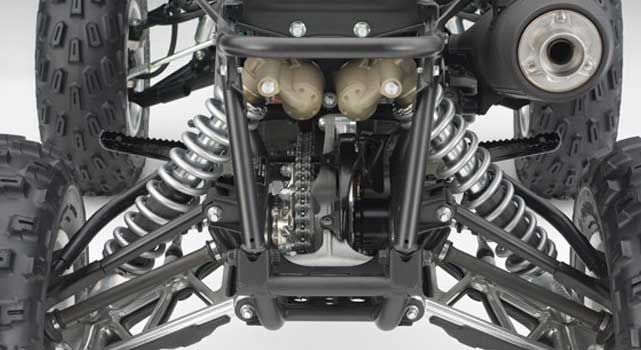Gearing Up (or Down) for Performance
Jul 7th 2019
Gearing Up (or Down) for Performance

POP QUIZ: What’s the best and most easiest bang-for-your-buck performance trick for motorcycles and ATVs?
I’ll give you a couple of hints. It’s not a complete engine overhaul, nor is it forced induction and it certainly isn’t nitrous spray.
Give up? Well, here’s the answer.
REAR SPROCKET CHANGE

The rear sprocket and chain on a Honda TRX 700XX.
You may recall our earlier post on How to Change an ATV Chain and Sprocket, where we broke down the process in 9 easy steps. Replacement of the stock sprocket with a brand new OEM-spec sprocket from Race Driven helps to ensure that your machine performs like it did on the day it left the factory. When to change a rear sprocket depends on how often you ride, how you ride, and where you ride but if you’re looking to upgrade from bone stock, you can drastically change your motorcycle or ATV’s performance characteristics by adjusting the final drive ratio with larger or smaller sprockets.
WHAT DOES ‘FINAL DRIVE RATIO’ MEAN?
Final drive ratio refers to torque multiplication at the very last bit of gearing between the transmission and the drive wheels. When multiple gears mesh together, they form a gear chain. The total number of teeth on each gear is the gear ratio. To calculate the ratio, count the number of teeth on the gear attached directly to the power source and the last gear in the chain. The final drive ratio is the number of teeth on the input gear to the output gear. For example, if an input gear has 10 teeth and is driving the output gear which has 41 teeth, the ratio will be 4.10:1. This means that it takes 4.10 turns of the input gear to turn the output gear 1 time. Torque has been multiplied 4.10 times. In a car or truck, the final drive is the transmission gear ratio and the rear differential gear ratio. For motorcycles and ATVs, the final drive ratio is the last gear in the transmission to the *rear sprocket.
The final drive ratio is actually what determines the power delivery characteristics of your vehicle. Modifying the rear differential with taller (LOWER ratio number) or shorter (HIGHER ratio number) gears can transform an otherwise stock powertrain for increased top speed or faster acceleration. There is, however, a trade-off for each option. Tall gear ratios (example: 2.79, 2.90, 3.00, 3.25) offer higher top speeds and (somewhat, depending on the application) better fuel economy but at the cost of acceleration. Short gears (example: 3.73, 3.91, 4.11, 4.30) will help you get off the line faster and shorten your 0-60 times, but you can expect a dip in top-end speed and a hit in your fuel economy. Cars and trucks are engineered from the factory to deliver both optimal driving performance and maximum fuel economy and this is accomplished by equipping them with gear sets that, more or less, are designed to deliver the best of both worlds. For those who just can’t leave well enough alone, there are aftermarket gear sets and some manufacturers even offer their own factory-authorized products. Because a honkin’ big engine with street-shredding horsepower and stump-pulling torque can help satiate your power needs but it won’t do much if it isn’t matched to a transmission and rear end that can best optimize that power.
This same principle can be applied to motorcycles, dirt bikes, sport bikes, ATVs, and UTVs. The difference is that instead of tearing apart a rear differential and worrying about getting splashed with stinky rear differential fluid, it involves a simple swap of the *rear sprocket.
*Some ATVs and UTVs use a full differential like a car or a truck.
GEAR UP OR GEAR DOWN

Rear sprockets for a 2006-2010 Suzuki GSX-R600. The gear above has 41-teeth while the one at the bottom has 47.
To ‘gear up’ or “gear down’ means whether or not you want more top-end speed or more low-end torque. A smaller rear sprocket is ideal for gearing up, which will give you increased top-end speed for situations like large superspeedway or road course racing and overtaking on long straightaways. Gearing down with a larger rear sprocket can be useful in drag racing to help get the jump at the starting line and in off-roading, where low-end torque is needed to push and crawl your way through treacherous terrains at low but stable speeds. Both applications have their advantages and disadvantages in performance. Which one is best for you all depends on your riding style and the type of riding you do.
This chart can help you decide whether gearing up or gearing down will best suit your performance needs.

TIPS
Whenever you change a sprocket, you'll also need to change the chain. Usually, this is due to the wear and tear of riding but in a performance application such as gearing up or down, you're going to want to make sure that you have a chain that fits properly and without any power-robbing slack. Don't mix an old chain with a new sprocket (or vice versa) or else you will shorten the lifespan of both parts. Check out our inventory of aftermarket chains and our tools and accessories section for the necessary chain breakers and chain alignment tools required to do the job.
Changing one tooth on the countershaft sprocket can have a larger impact on gearing than changing one tooth on the rear sprocket, but changing a rear sprocket allows you to fine-tune your adjustments according to your performance desires.
On 4-wheel drive vehicles, front sprockets can also be changed and should be changed as part of regular maintenance. However, you should avoid using front sprockets that are smaller than the original or stock equipment. The drive chain must turn a tighter radius which, in turn, increases friction and decreases the life of the chain.

